The disinformation campaign to define U.S. protesters as ‘terrorists’
Disinfo about “antifa” influenced U.S. policy
The disinformation campaign to define U.S. protesters as ‘terrorists’
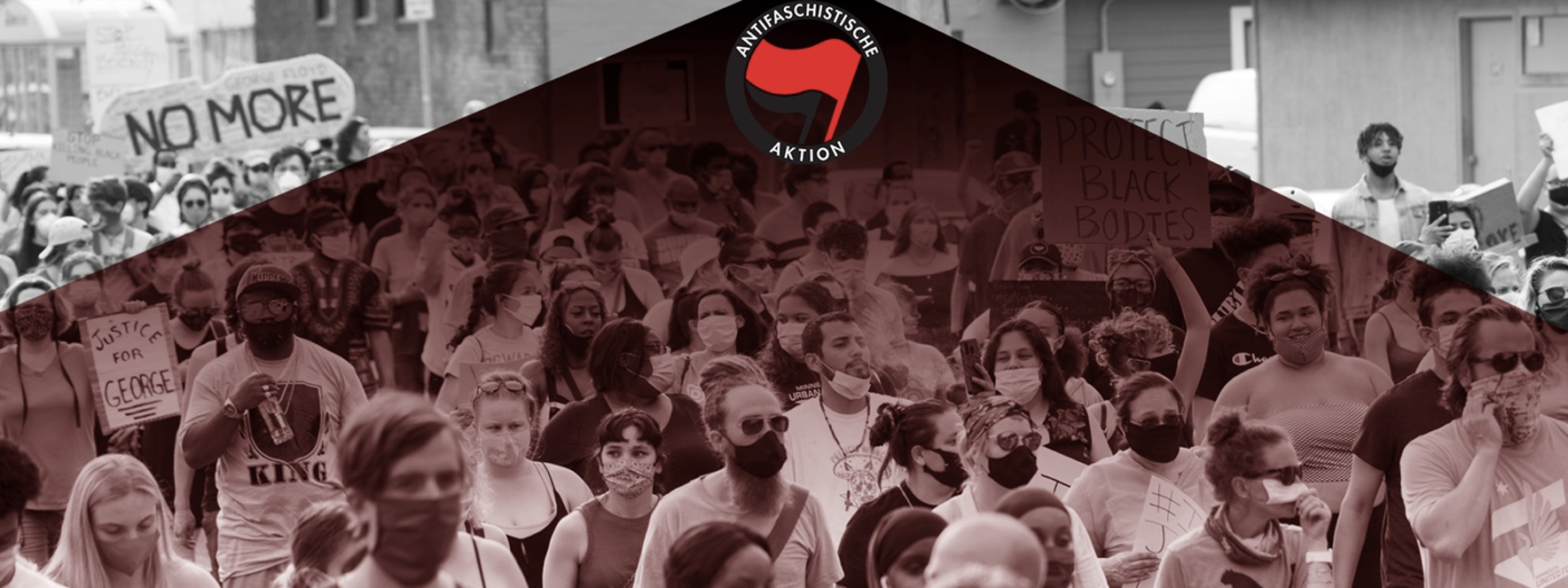
Disinfo about “antifa” influenced U.S. policy and shaped broader perceptions of George Floyd protests
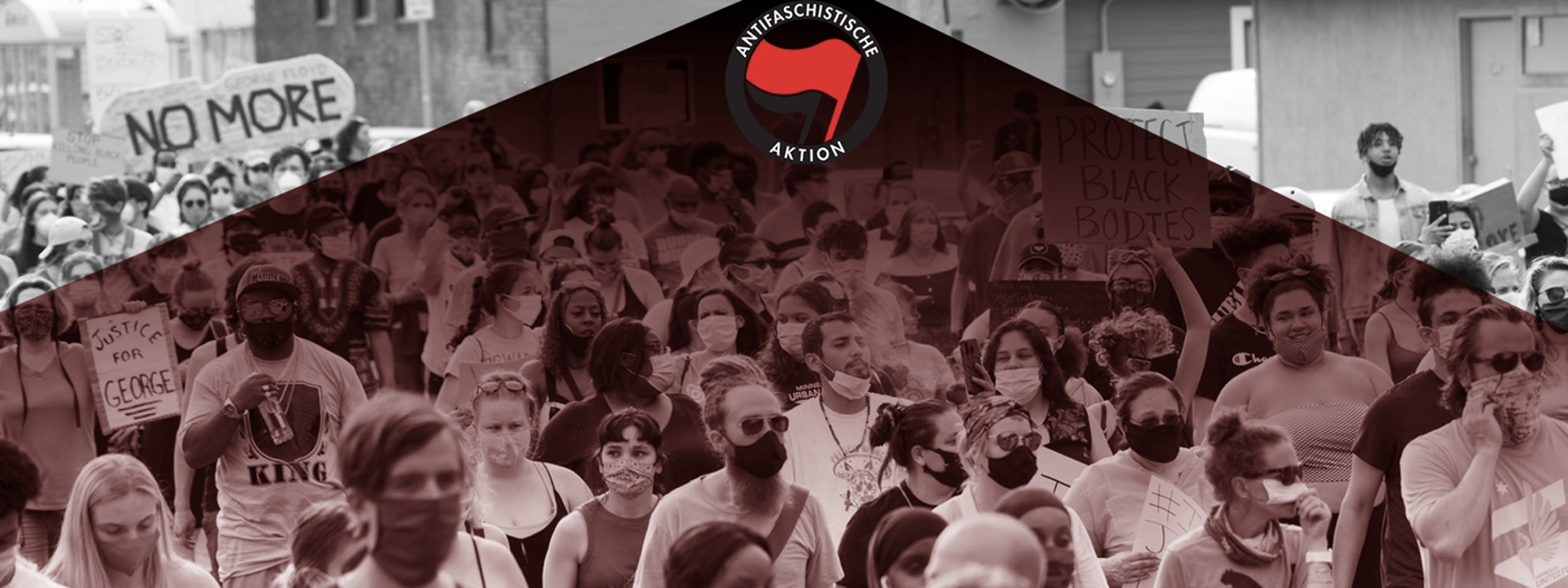
A disinformation campaign has gained traction across the United States, spreading fears of antifa “terrorism” by way of largely spurious, decontextualized, or provably false claims. These fears have been cited by some U.S. officials as they push for a punitive law enforcement response and military deployments against overwhelmingly peaceful protesters. These fears have also sparked acts of targeted harassment, armed assaults, and general panic in American towns.
This case demonstrates the unique threat that viral falsehoods pose during rapidly evolving events. It also shows how false claims, circulated by a powerful network of social media influencers, can shape public perception and delegitimize popular movements like the George Floyd protests.
Following the May 25, 2020 killing of George Floyd, an unarmed African American man, by Minneapolis police, far-right activists began waging a disinformation campaign to discredit the resultant protests against police violence and systemic racism. The campaign has sought to connect the sporadic street violence of “antifa” direct action groups with domestic terrorism, erase distinctions between this small number of antifa activists and hundreds of thousands of peaceful demonstrators, and generally confuse conversation around the protest movement. The intent appears to be the conflation of the broader protests with terrorist activities.
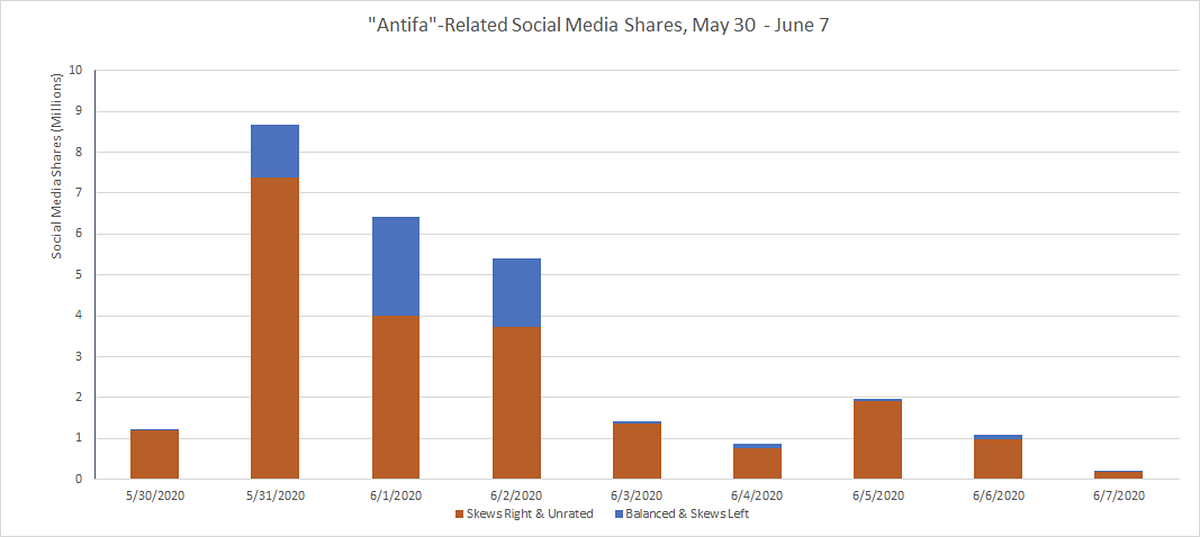
On social media, antifa-related content has seen a surge in engagement. Between May 25 and June 7, approximately 12,000 articles and videos shared on major platforms — Facebook, Twitter, and Reddit — included a keyword reference to “antifa,” according to a scan conducted via BuzzSumo. This content has received roughly 27 million shares in total, three-fourths of which originated from right-leaning media outlets. Many of these stories are alarmist in nature, misrepresenting or fabricating violent incidents in order to maximize their digital traction. Over time, they have begun to claim a larger share of antifa-related content. Indeed, according to Google Trends, total search interest in “antifa” outperformed that in the Black Lives Matter movement between May 25 and June 7.
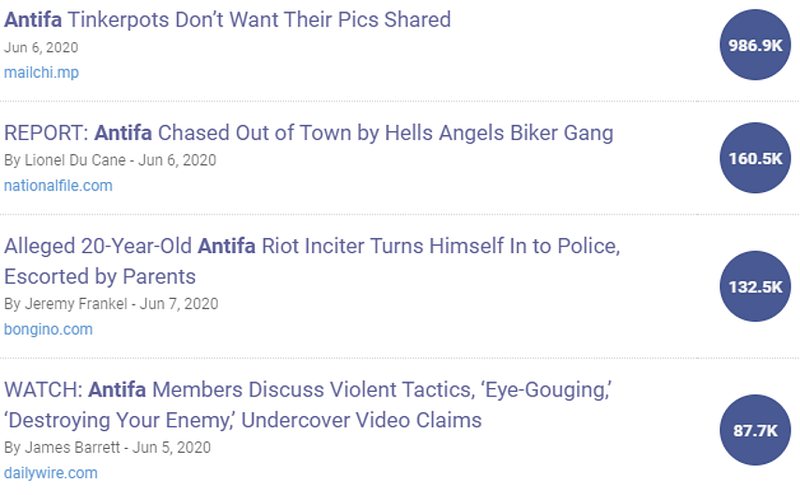
This audience reach is not limited to web publications. According to data collected via CrowdTangle, there were roughly 44,000 antifa-related Facebook posts between May 25 and June 7, receiving approximately 28 million interactions. All 10 of the most popular posts associated antifa with domestic terrorism. Additionally, 5,600 antifa-related Instagram posts received 12 million interactions over this same period. Seven of the 10 most popular posts again associated antifa with domestic terrorism. Of the remainder, one was an apolitical post via Worldstarhiphop; two were messages of solidarity from a popular Spanish-language anti-fascist account in Brazil.
The campaign is most apparent on Twitter. According to a review of the platform using social media monitoring tool Meltwater Explore, “antifa” received approximately 16 million mentions between May 25 and June 7. The majority of these mentions were deeply negative, accusing antifa of terrorism, arson, and even child trafficking. Each of these claims was amplified hundreds of thousands of times.
Antifa and U.S. protests since 2016

The origins of the far-right campaign against antifa can be traced to street violence that has erupted intermittently between anti-fascist and far-right demonstrators since President Trump’s election in November 2016. These have notably included nationwide protests that occurred in November 2016 and again in January 2017; confrontations at the University of Berkeley in February and August 2017; violence during the “Unite the Right” white nationalist rally in Charlottesville, Virginia in August 2017; and prolonged fighting at Portland, Oregon protests in April 2017 and June 2019. Because of the volume of far-right influencers present at these events — each with a large, highly engaged online following — these events had an outsize digital footprint and received significant coverage from conservative media, and subsequently more mainstream media outlets.

During and after each of these confrontations, far-right activists have sought to describe antifa as a domestic terrorist organization, occasionally amplified by Russian sockpuppets. Here, however they have run into definitional challenges. Antifa is not an organization, but rather a general movement that advocates for direct physical confrontation with perceived fascist forces. Its adherents represent a mix of anarchists, communists, Marxists, and militant socialists — but only a small fraction of any one of these communities.
Moreover, it has never been apparent that antifa poses an organized terrorist threat. According to a comprehensive database maintained by the National Consortium for the Study of Terrorism and Responses to Terrorism, “Far-Left” ideologies accounted for zero deaths between 2010 and Q1 2019, in contrast to 140 deaths due to “Far-Right” ideologies. Virtually all U.S. terror plots in the last three years have been linked to white-nationalist extremists.
Despite this evidence, far-right activists have remained persistent in their attacks on antifa and vocal in their desire to see the movement labeled as a terrorist organization. Shortly after the killing of George Floyd and resultant protests against police violence and systemic racism, these activists set to work.

From online misinformation to U.S. government policy
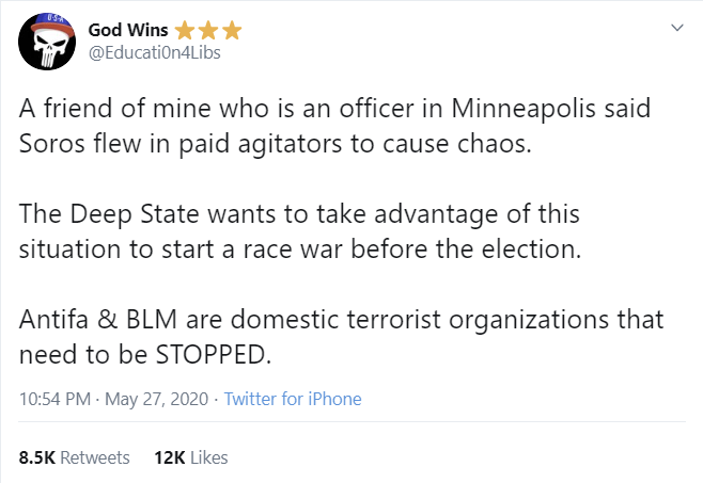
The first noteworthy Twitter mention of antifa in relation to the George Floyd protests came late in the evening of May 27, on the second night of demonstrations in Minneapolis. The tweet, from a popular QAnon account, alleged that the protests were the work of financier George Soros and that the “Deep State” intended to start a “race war.” The tweet accused both antifa and the Black Lives Matter movement of being terrorist organizations. This false claim was shared roughly 8,500 times over the next 24 hours, igniting a frenzy of speculation and further responses.
By May 29, Twitter mentions of antifa and “terrorism” reached 21,000. On May 30, they grew by an order of magnitude to 173,000. Thousands of influential far-right Twitter accounts began to lobby President Trump directly to designate antifa a domestic terrorist organization. That same day, the campaign moved into right-leaning web publications, resulting in more than 1 million article and video shares. Virtually all of this content accused antifa of terrorist activities.
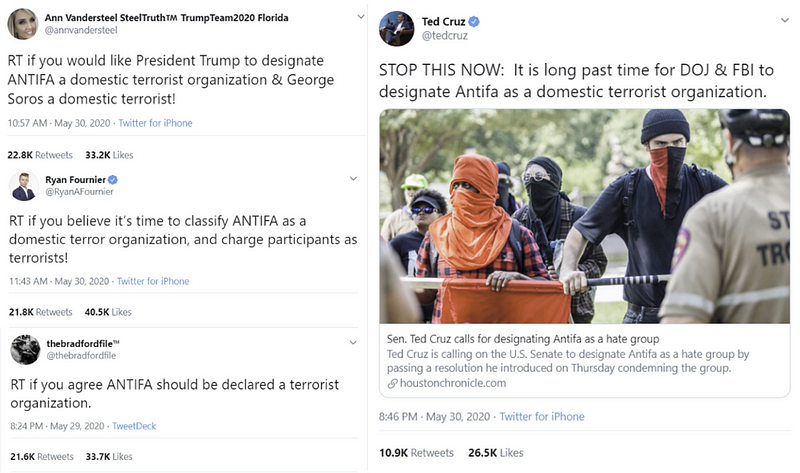
This lobbying effort did not escape Trump’s attention. Indeed, it likely appeared directly on his smartphone. Trump follows only 46 accounts on Twitter. Excluding the accounts of U.S. officials and Trump properties, the president follows 28 American media personalities and conservative activists. On May 30, roughly 10 percent of the Twitter activity from this group regarded purported antifa terrorism. By midday, Trump himself had joined the choir. “It’s ANTIFA and the Radical Left,” he wrote. “Don’t lay the blame on others!”
On May 31, Trump announced, “The United States of America will be designating ANTIFA as a Terrorist Organization.” While the designation was legally specious (the United States has no mechanism for domestic terrorism classification), it sent shockwaves through conservative media and far-right activist communities. Twitter mentions of antifa and “terrorism” peaked at nearly 1 million, while related stories by right-leaning publications received almost 9 million social media shares. That same day, the U.S. Drug Enforcement Administration received new authorities to “conduct covert surveillance” on the George Floyd protests, alongside an unknown number of other federal agencies.
Also on May 31, the FBI’s Washington Field Office internally concluded that it “ha[d] no intelligence indicating antifa involvement/presence” related to the sporadic violence that had broken out amid overwhelmingly peaceful protests in Washington, DC.

Ongoing campaign to associate George Floyd protesters with antifa and “terrorism”
Beyond associating antifa with terrorism, far-right activists have also sought to delegitimize the broader George Floyd protests. Of 48 pieces of viral misinformation reviewed by BuzzFeed reporters Jane Lytvynenko and Craig Silverman between May 29 and June 7, nearly one-third involve a nonexistent attack — a suspected murder, explosion, or act of animal cruelty — intended to make the movement appear as violent as possible.
With President Trump’s declaration of antifa as a domestic terrorist organization, this delegitimization effort received a powerful new amplifier. Between June 3 and June 7, Trump’s re-election campaign sent four emails to millions of supporters that referenced “Dangerous MOBS” and “THUGS” in the process of “DESTROYING our cities and rioting.” These emails referenced the president’s designation of antifa as a domestic terrorist organization. None mentioned the broader context of the George Floyd protests or the presence of hundreds of thousands of peaceful demonstrators.
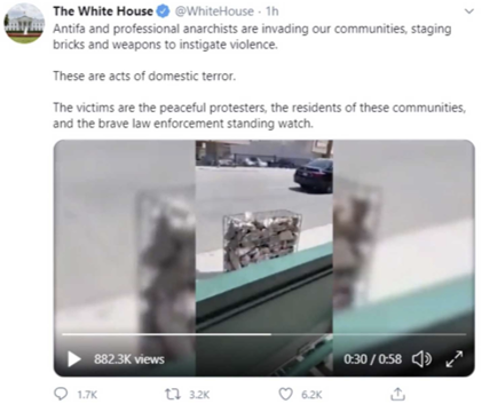
The same principle has applied to public U.S. government communications. On June 3, the official White House account shared — and subsequently deleted — a video that falsely claimed that a rock-filled anti-terrorism barrier outside a synagogue had been set up by “antifa and professional anarchists” in order to throw bricks at police officers. On June 4, Trump shared a letter with his roughly 82 million Twitter followers which referred to the George Floyd protesters as “not peaceful and…not real.” Rather, the letter claimed, “They are terrorists using idle hate filled students to burn and destroy.” On June 9, Trump implied that a 75-year-old protester critically injured by police in Buffalo, New York had in fact been an “ANTIFA provocateur.” In so doing, Trump amplified a conspiracy theory that had originated three days earlier in far-right fringe media.

Meanwhile, on June 4, U.S. Attorney General William Barr alleged that the George Floyd protests had been infiltrated by a “witch’s brew” of different extremist organizations. He cited no evidence and refused to name any group besides antifa, despite news of an FBI arrest of far-right militants that same day. They belonged to the loosely organized “Boogaloo” movement, whose most extreme adherents seek to incite a second American Civil War by means of deadly “false flag” attacks.
This flood of viral dis- and misinformation, coupled with misleading statements by President Trump and senior U.S. administration officials, has resulted in a growing national panic most concentrated in smaller U.S. communities. Local U.S. newspapers have examined and debunked rumors that antifa has dispatched “a planeload of their people” to Payette County, Idaho or that buses of violent infiltrators are descending on places like Klamath Falls, Oregon or Casper, Wyoming.
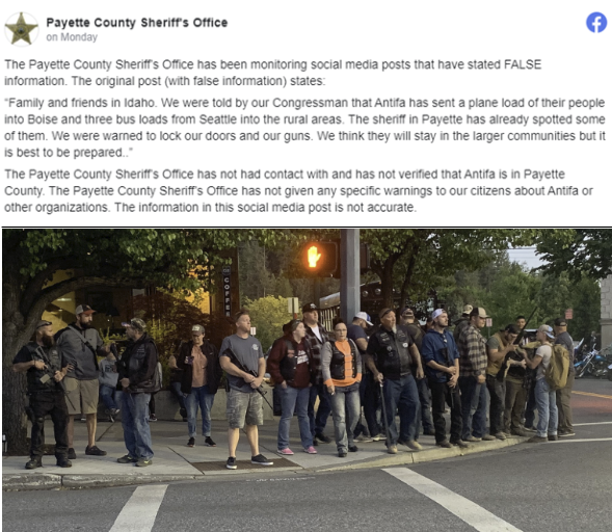
As misinformation and paranoia spread, some Americans have tried push back against the “terrorist” threat. In Forks, WA, a multi-racial family was reportedly accused of being “members of antifa” and was subsequently harassed, including an attempt to fell trees to trap them in their isolated campsite. In McAllen, TX, a man brandished a chainsaw at peaceful protesters, screaming for them to disavow “antifa bullshit.”

The DFRLab defines disinformation as “false or misleading information, spread with the intention to deceive.” Ongoing efforts by far-right activists to decontextualize the George Floyd protests and amplify false narratives meet this criteria. Moreover, this disinformation campaign has clearly been effective. It has already led to formal changes in U.S. government policy and sown panic in U.S. towns. In the minds of millions of Americans, it has indelibly linked the George Floyd protests to domestic terrorism. With time, it may lead to more counter-reactionary protests — and more potential for violence.
* Determination of “Skews Left,” “Balanced,” and “Skews Rights” publication categories based on Version 5.1 of the Media Bias Chart by ad fontes media. Via BuzzSumo search, the 100 most-shared “antifa”-related articles and videos were reviewed. 30 outlets were determined to be “Balanced” or “Skews Left” and were subsequently excluded from the “Skews Right” query. Unrated outlets were included in the “Skews Right” query, as they almost universally echoed or exaggerated other “Skews Right” headlines. While one cannot determine how many of the 12,000 total pieces of content fit in the “Skews Left,” “Balanced,” or “Skews Right” category, one can state that “Skews Right” content constituted roughly three-fourths of the total 27 million social media shares.
Emerson T. Brooking is a Resident Fellow with the Digital Forensic Research Lab.
Follow along for more in-depth analysis from our #DigitalSherlocks.

